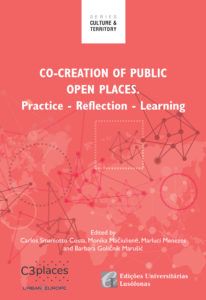Culture & Territory
Vol.04 Co-Creation of Public Open Spaces. Practice - Reflection - Learning

- Vol.04 Co-Creation of Public Open Spaces. Practice - Reflection - Learning
- Carlos Smaniotto Costa, Monika Mačiulienė, Marluci Menezes & Barbara Goličnik Marušić - Authors & Editors
- 2020
- ISBN 978-989-757-125-1 | ISSN 2184-8009
- DOI: https://doi.org/10.24140/2020-sct-vol.4
Synopsis
The chapters of this book bring science a little closer to the knowledge about the design, production and management of public spaces. 37 authors responded to the Project’s call to share experiences, visions and reflections on how co-creation and participatory processes can create possibilities for a sustainable and equitable future. This book intends to help researchers, governments and community leaders to move from insights to more collaborative actions.
Smaniotto Costa, C., Mačiulienė, M., Menezes, M. & Goličnik Marušić, B. (Eds.)(2020). Co-Creation of Public Open Places. Practice – Reflection – Learning. C3Places Project. Culture & Territory, volume 4. Lisbon: Lusófona University Press. https://doi.org/10.24140/2020-sct-vol.4
Table of Contents
FOREWORD
Carlos Smaniotto Costa, Marluci Menezes, Monika Mačiulienė and Barbara Goličnik Marušić. pages 8-16
Are urban living labs the new normal in co-creating places?
Jonas Bylund, Johannes Riegler, Caroline Wrangsten
https://doi.org/10.24140/2020-sct-vol.4-0 pages 17-21
Part I - Co-creation and participative processes
1.1 Understanding co-creation within the urban open space development process
Barbara Goličnik Marušić, Ina Šuklje Erjavec
https://doi.org/10.24140/2020-sct-vol.4-1.1 pages 25-37
1.2 Assessing Digital Co-Creation in Urban Transformations: Case of Vilnius
Aelita Skaržauskienė, Monika Mačiulienė, Laura Gudelytė
https://doi.org/10.24140/2020-sct-vol.4-1.2 pages 39-53
1.3 The production of public open spaces and the deliberate exclusion of undesirables
Carlos Smaniotto Costa, Catarina Patrício
https://doi.org/10.24140/2020-sct-vol.4-1.3 pages 55-69
1.4 Public Spaces, spaces of public domain: Icons of a contemporary simulacrum?
Manoel Rodrigues Alves
https://doi.org/10.24140/2020-sct-vol.4-1.4 pages 71-83
1.5 Exploring co-creation as a learning process to (re)think public space from a transformative perspective
Marluci Menezes, Diogo Mateus
https://doi.org/10.24140/2020-sct-vol.4-1.5 pages 85-94
1.6 Participatory Design as a Tool to Create Resourceful Communities in Sweden
Agatino Rizzo, Björn Ekelund, Jenny Bergström, Kristina Ek
https://doi.org/10.24140/2020-sct-vol.4-1.6 pages 95-107
1.7 Placemaking with teenagers. Experiences driven from thematic workshops on urban planning
Inês Almeida, Joana Solipa Batista, Filipa Lourenço
1.8 The design of co-participation processes in public spaces in São Paulo as university extension project: The revitalization process of Dom Orione and Major Freire Squares
Débora Sanches, Sérgio Ricardo Lessa Ortiz
https://doi.org/10.24140/2020-sct-vol.4-1.8 pages 125-136
1.9 Use and appropriation as the everyday design of public space in the Bexiga neighbourhood (São Paulo)
Lucas Ariel Gomes, Silvia A. Mikami G. Pina
https://doi.org/10.24140/2020-sct-vol.4-1.9 pages 137-148
1.10 Producing collaborative public space - The Laboratory of Intervention in Architecture in situ / experiment
Filipa Ramalhete
https://doi.org/10.24140/2020-sct-vol.4-1.10 pages 149-162
Part II - The digital in the production public open spaces
2.1 Categorisation of digital tools for co-creation of public open spaces. Key aspects and possibilities
Ina Šuklje Erjavec, Vita Žlender
https://doi.org/10.24140/2020-sct-vol.4-2.1 pages 165-183
2.2 Modifying and co-creating the urban soundscape through digital technologies
Dick Botteldooren, Toon De Pessemier, Karlo Filipan, Kang Sun, Bert De Coensel, Timothy Van Renterghem pages 185-200
https://doi.org/10.24140/2020-sct-vol.4-2.2
2.3 The effect of public places on community resilience. A case study of the role of social and digital tools in the City of Volos (Greece)
Tatiana Ruchinskaya, Konstantinos Lalenis pages 201-214
https://doi.org/10.24140/2020-sct-vol.4-2.3
2.4 Technology and community communication: the use of the radio broadcasting as a strategy for urban sustainability
Edney Mota Almeida, Lúcio Hanai Valeriano Viana pages 215-226
https://doi.org/10.24140/2020-sct-vol.4-2.4
2.5 Web 2.0 tools as framework for participation and co-creation
Igor Bizjak pages 227-241
https://doi.org/10.24140/2020-sct-vol.4-2.5
2.6 Planning of public open spaces with digital tools. The example of the WAY CyberParks
Tiago Duarte, Diogo Mateus pages 243-255
https://doi.org/10.24140/2020-sct-vol.4-2.6
Notes on Contributors pages 255-263


